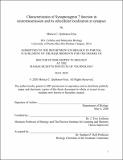| dc.contributor.advisor | J. Troy Littleton. | en_US |
| dc.contributor.author | Quiñones-Frías, Mónica C.(Mónica Cristina) | en_US |
| dc.contributor.other | Massachusetts Institute of Technology. Department of Biology. | en_US |
| dc.date.accessioned | 2020-09-03T17:48:40Z | |
| dc.date.available | 2020-09-03T17:48:40Z | |
| dc.date.copyright | 2020 | en_US |
| dc.date.issued | 2020 | en_US |
| dc.identifier.uri | https://hdl.handle.net/1721.1/127136 | |
| dc.description | Thesis: Ph. D., Massachusetts Institute of Technology, Department of Biology, May, 2020 | en_US |
| dc.description | Cataloged from the official PDF of thesis. | en_US |
| dc.description | Includes bibliographical references. | en_US |
| dc.description.abstract | Synaptic vesicle (SV) fusion is dependent on proteins that can sense Ca²⁺ and trigger fusion with the plasma membrane. Neurotransmitter release occurs during a rapid synchronized phase of SV fusion mediated by the Ca²⁺ sensor Synaptotagmin 1 (SYT1). A slower SYT1-independent asynchronous phase is also present at many synapses and has been hypothesized to be mediated by another Synaptotagmin, SYT7. To determine if SYT7 plays an evolutionarily conserved role as an asynchronous Ca²⁺ sensor, we used the CRISPR-Cas9 system to generate mutations in the Syt7 locus and introduced tags to label the endogenous protein in Drosophila. Electrophysiology, FM1-43 analysis and quantal imaging revealed that release probability is elevated 2-fold at larval neuromuscular junctions (NMJs) in Syt7 mutants. No structural changes were identified that could contribute to the elevated evoked response. | en_US |
| dc.description.abstract | Syt1/Syt7 double mutants also display more release than Syt1 mutants alone, indicating SYT7 is not the asynchronous release Ca²⁺ sensor. Syt7 mutants display a larger pool of releasable vesicles during high frequency stimulation and a faster recovery of releasable SVs following stimulation, suggesting SYT7 is likely to regulate SV trafficking. Endogenously-tagged SYT7 localizes to a presynaptic membrane compartment called the periactive zone that has been implicated in SV endocytosis and recycling. SYT7 forms an internally connected presynaptic membrane compartment that surrounds and contacts a host of other intracellular compartments, including endosomes, ER and lysosomes. In addition to regulating asynchronous release, SYT7 is also known to regulate facilitation and vesicle replenishment. Heterogeneity of SYT7 functions across neurons could arise from posttranslational modification of SYT7 at synapses or differential expression of SYT7 across different neuronal populations. | en_US |
| dc.description.abstract | The Drosophila NMJ serves as an ideal model synapse to study how SYT7 regulates SV fusion in different neuronal types because muscle contraction is regulated by two glutamatergic motor neuron populations that exhibit tonic and phasic electrophysiological properties. Preliminary data suggests that SYT7 levels might differentially regulate release probability in tonic and phasic neurons at NMJs. In addition, initial structure function studies of SYT7's C2 domains suggest they redundantly aid in trafficking SYT7 to nerve terminals, but are also required for normal stability of the protein. | en_US |
| dc.description.statementofresponsibility | by Mónica C. Quiñones-Frías. | en_US |
| dc.format.extent | 166 pages | en_US |
| dc.language.iso | eng | en_US |
| dc.publisher | Massachusetts Institute of Technology | en_US |
| dc.rights | MIT theses may be protected by copyright. Please reuse MIT thesis content according to the MIT Libraries Permissions Policy, which is available through the URL provided. | en_US |
| dc.rights.uri | http://dspace.mit.edu/handle/1721.1/7582 | en_US |
| dc.subject | Biology. | en_US |
| dc.title | Characterization of synaptotagmin 7 function in neurotransmission and its subcellular localization at synapses | en_US |
| dc.type | Thesis | en_US |
| dc.description.degree | Ph. D. | en_US |
| dc.contributor.department | Massachusetts Institute of Technology. Department of Biology | en_US |
| dc.identifier.oclc | 1191838590 | en_US |
| dc.description.collection | Ph.D. Massachusetts Institute of Technology, Department of Biology | en_US |
| dspace.imported | 2020-09-03T17:48:40Z | en_US |
| mit.thesis.degree | Doctoral | en_US |
| mit.thesis.department | Bio | en_US |
